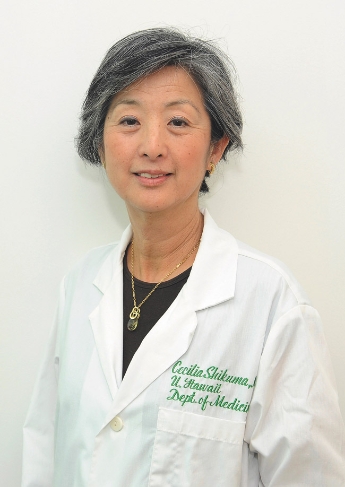Progress With AIDS/HIV Treatment
Dr. Cecilia Shikuma
Director of Hawaii Center for AIDS
Where did you receive your schooling/training?
At the John A. Burns School of Medicine and University of Southern California, Los Angeles County Medical Center.
Are you mostly engaged in research or do you have an ongoing practice?
I am mostly involved in research but do practice in our HIV clinic called the Clint Spencer Clinic, named after our community advisory board member who was our first research patient. I have been a practicing physician for 25 years.
Since HIV/AIDS first surfaced, the attention given to the disease seems to have waned. Why is that?
In the ’80s we had no good antiretroviral medications. HIV led to AIDS with onset of life-threatening, AIDS-defining infections and tumors, with the onset of death roughly one year after AIDS was diagnosed. In 1996, the first group of powerful antiretroviral medications called protease inhibitors was approved by the FDA and became widely available in the U.S. These protease inhibitors were used in combination with older antiretroviral medications and, for the first time, this “combination therapy” led to almost complete suppression of free HIV virus circulating in the bloodstream – a state commonly referred to as an “undetectable viral load.” With these types of therapy, HIV-infected individuals typically no longer developed AIDS. They gained weight, and many who thought they were dying were able to return to a fully functional life and resume working. I believe one of the reasons that we do not hear much about HIV/AIDS is that we are now able, with therapy, to arrest the disease and keep HIV infection mostly in check.
Is there a cure on the horizon?
We cannot cure HIV. This is because the HIV virus embeds itself within your genetic structure in immune cells that are resting and not actively replicating. Antiretroviral drugs that currently are available can kill these cells only if the cells are active. How to cure HIV is a very hot area of research right now that our research program also is working on. To date, there have been at least two well-documented individuals who have been cured of HIV, so we know that this is possible. One case in particular is interesting: This individual was HIV-infected and developed leukemia, for which he needed a bone marrow transplant. He underwent transplantation from a donor who had a genetic variant that makes the immune cells more resistant to infection with HIV. As transplantation carries a huge risk of death, this is not something that is likely to be used as a therapeutic modality for curing HIV, but it has been exciting for the research community to realize that a cure is something that may be possible.
Currently, antiretroviral therapy needs to be continued lifelong. If antiretroviral therapy is stopped, the HIV virus promptly reappears in the bloodstream, presumably from some of the resting cells that have become active. Most of the newer drugs that have come on the market are directed toward making HIV therapy simpler. There are now three one-pill-once-a-day combination pills, which is a far cry from days when patients had to take multiple medications four or even six times a day. The medications also are less toxic with fewer side effects.
What is the latest with HIV/AIDS research?
Seeking a cure is one major effort. The other effort we have been involved in has to do with complications of HIV. We have been finding out that even with good antiretroviral therapy, HIV-infected individuals have increased risk of many of the non-infectious complications we associate with aging, such as cardiovascular disease, diabetes and cognitive impairment. We have ongoing research in each of these areas. One area that the Hawaii Center for AIDS (HICFA) has a particular interest in currently is cognitive impairment associated with HIV. We are finding that up to 50 percent of our HIV-infected individuals over the age of 40 have some degree of cognitive impairment. Most of it is mild impairment, but this is likely to prevent patients from functioning optimally at work and may even start to impact the ability to live independently. We at HICFA feel that this is a major problem in our HIV-infected patient population. We think we have discovered why this is happening, and we are in the process of starting some clinical trials to see if we can reverse some of this impairment. We encourage MidWeek readers who are HIV-infected and interested in our clinical trials to call us to find out more (692-1310).
Are there any HIV/AIDS statistics for Hawaii, i.e., how much better or worse we’re doing than the rest of the nation?
States vary widely in how much HIV disease there is within their state. Hawaii is better than some states and worse than others. Hawaii has a very active Department of Health STD branch, and this branch has really worked hard to make sure that HIV infection is not out of control. We have less transmission from intravenous drug use because of a very effective needle-exchange program. For those who wish to be tested for HIV, anonymous and rapid saliva tests are available at various sites on the island.






